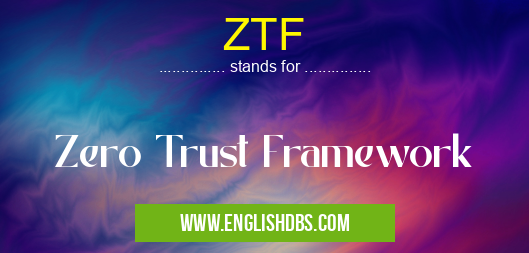What does ZTF mean in UNCLASSIFIED
Zero Trust Framework (ZTF) is an architecture model and strategy which has been developed by several IT security experts to better equip businesses for dealing with cyber-security threats. This framework focuses on providing a secure environment that is based on the principle of zero trust, which means that all users and devices are treated as untrustworthy and must be carefully authenticated before being granted access to any network resources. ZTF involves robust identity management, authentication, monitoring, authorization, encryption and other processes to protect corporate networks from malicious actors. In effect, this framework states that all entities within a system should be regarded as equally insecure and highly validated before any access or communication is allowed or established.

ZTF meaning in Unclassified in Miscellaneous
ZTF mostly used in an acronym Unclassified in Category Miscellaneous that means Zero Trust Framework
Shorthand: ZTF,
Full Form: Zero Trust Framework
For more information of "Zero Trust Framework", see the section below.
Definition
ZTF stands for Zero Trust Framework. It is an architecture model and strategy created to provide businesses with a secure environment based off the principle of zero trust. It requires authentication of all users/devices accessed through a system regardless of location or device. Additionally, it includes processes like identity management, authorization, encryption etc., which help to protect against malicious actors attempting to compromise the structure of a network.
Essential Questions and Answers on Zero Trust Framework in "MISCELLANEOUS»UNFILED"
What is Zero Trust Framework?
Zero Trust Framework is an IT security concept that encourages organizations to move away from traditional trust-based defenses and instead verify the identity of all users before granting them access. It emphasizes the need for continuous protection, regardless of network location. Zero Trust shifts security strategy from protecting physical locations and infrastructure to validating identity, device security posture, and data sensitivity dynamically.
What are the benefits of Zero Trust?
The key benefit of Zero Trust is enhanced security due to increased visibility into user activity. It also helps reduce complexity by allowing for more granular access control policies as well as reducing the attack surface by stating that zero trust should be applied between all services within an organization.
How does Zero Trust work?
Zero Trust works by ensuring that every user or system within an organization must authenticate themselves before being granted access to resources and networks. This authentication process involves verifying the identity of users through multi-factor authentication methods such as passwords, biometrics, or tokens; verifying the security posture of devices connected to the network; and classifying sensitive data in order to grant access on a need-to-know basis.
Who needs Zero Trust?
Companies who are looking for improved visibility into user activity, want a way to reduce complexity while still meeting their compliance requirements, or those who have experienced a breach due to inadequate network defenses should seriously consider implementing a zero trust framework.
Is Zero Trust just another buzzword?
While there may be terms thrown around like "Zero Trust" and "Zero Security" that can feel like buzzwords, it's important not to get confused between what these terms mean in theory versus what they actually represent in practice. Achieving complete zero trust requires real effort on behalf of an organization but once implemented can provide substantial improvements in safety over traditional defense models.
What tools are needed for a successful implementation of a Zero Trust Framework?
The tools needed for successful implementation will vary depending on each organization's individual needs; however, common components include identity management solutions such as multi-factor authentication systems (MFA), advanced analytics solutions for real-time monitoring/assessment of user behavior, privileged access management (PAM) solutions that protect privileged accounts from misuse or unauthorized access, firewall/network segmentation solutions to help contain threats throughout the network environment, containerization/microservices platforms to quickly spin up applications securely without compromising core systems, and workload isolation platforms that apply distributed security controls at runtime rather than static rule sets.
Are there any special considerations when deploying aZero Trust Framework?
Yes—when deploying a zero trust framework it’s important to keep in mind your overall business objectives such as cost savings and application speed while still properly securing your infrastructure with an appropriate level risk tolerance based on industry regulations and compliance standards. Additionally you may also want to ensure you’re selecting the right balance between strong authentication solution(s) required by regulators (while avoiding overburdening legitimate users). Appropriate assessment processes should also be developed for preventing malicious actors from gaining illegitimate privileged personnel credentials.
Final Words:
In conclusion, ZTF stands for Zero Trust Framework which is designed to ensure a secure environment despite potential malicious actors attempting to gain access through unauthorized sources. The main components include authentication and identity management for every user/device needing permission to access the system along with encryption and other processes in order to further protect organizations from cyber-attacks. As technology continues advancing at an exponential rate, implementing ZTF can help companies remain protected while utilizing cutting edge advances in data security technology.
ZTF also stands for: |
|
| All stands for ZTF |
